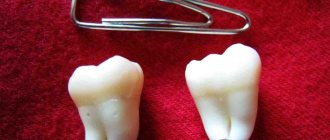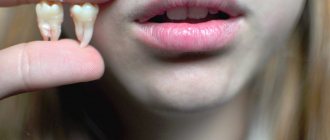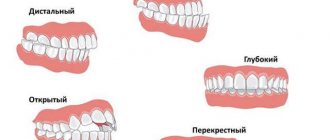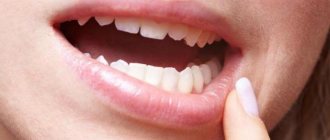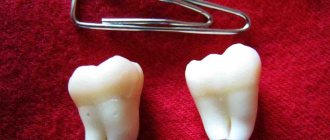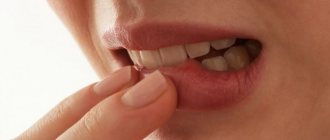Wisdom teeth are the last to take part in the formation of the human jaw. By the time they appear, the entire main dentition has already been formed. When wisdom teeth grow, characteristic symptoms arise; their appearance is accompanied by unpleasant and painful sensations, and sometimes complications. And yet, for some reason, nature created them.
Signs of growth of the eight
The emergence of a wisdom tooth to the surface is usually accompanied by pain. The discomfort is due to the fact that the bone tissue damages the gums. In addition, in place of wisdom teeth, precursors are not formed, which facilitate the process of the appearance of permanent elements. The pain when figure eights appear can be compared to the discomfort that small children experience during the process of teething. In addition to pain, other signs of the condition are also noted - itching, swelling of the soft tissues of the gums. Not in all cases, the teething process is accompanied by discomfort. Sometimes people discover a new tooth in their row completely by accident.
Other symptoms of the condition:
- swollen gums located away from the problem element;
- radiating pain to the head, ear or cheek;
- difficulty swallowing;
- the appearance of bad breath.
The last sign appears due to the fact that during the process of eruption a hood is formed above the figure eight. It is a compaction of overgrown mucous membranes. Plaque, bacteria, and food particles accumulate under the hood, eventually leading to bad breath.
In severe cases, a person develops symptoms of malaise and intoxication. Also, severe eruption of the element is accompanied by fever, inflammation of the submandibular lymph nodes, and severe headaches. Signs of the condition are individual for each person. There may be only one or many signs of a problem. The duration and intensity of the symptoms of figure eight eruption are also individual in each specific case.
Wisdom tooth hood
Complications associated with teething
With pathological germination of the figure eight, a number of complications can develop. A common disorder is pericoronitis. The disease is associated with inflammation of the tissues of the jaw and mucous membranes of the mouth.
Characteristic signs of pericoronitis:
- the appearance of severe swelling and redness in the eruption area;
- sore throat when swallowing;
- deterioration of health;
- weakness;
- temperature increase;
- discharge of purulent masses when pressing on the gums.
Often pericoronitis becomes chronic, which is accompanied by pain and discomfort when pressing on the problem area. An abscess may form in place of the tooth.
Carious lesion is another consequence of improper eruption of figure eights. The fact is that the last molars may fit too tightly to the sevens, which makes it difficult to naturally clean the dental space from plaque and bacteria. As a result, caries develops with all its characteristic symptoms:
- darkening of the enamel;
- pain when chewing;
- tooth sensitivity.
Sometimes it happens that the figure eight comes out on the surface of the already affected gum.
Periodontitis appears after the eruption of the last molar. The pathology is characterized by inflammation of the gums due to the inconvenient location of the wisdom tooth in the gum. In this case, plaque and bacteria from the oral cavity are almost impossible to remove using standard hygiene measures. Bacteria in the space between the gum and tooth provoke inflammation and swelling of the soft tissues of the mouth. If a visit to the dentist is untimely, periodontitis is complicated by gumboil or periostitis.
What to do if a wisdom tooth comes out and your gums hurt
Symptoms of flux manifest clearly and are accompanied by:
- temperature rise to 40 degrees;
- swollen cheeks;
- swelling spreading to most of the face;
- intoxication of the body;
- excruciating pain.
As a result of abnormal eruption of the figure eight, a cyst can grow - a benign tumor filled with clear liquid. It contains particles of dead cells, bacteria and food debris. You can notice a cyst by protruding gums and discomfort when chewing food. Rarely, a cyst is accompanied by severe pain.
The appearance of a wisdom tooth above or below can cause damage to the trigeminal nerve. If it is violated, there is involuntary twitching of the face and severe sharp pain. In severe cases, facial paralysis may occur.
Abscess is one of the most severe complications associated with the pathological eruption of the last elements. It develops in the most patient patients. Among the signs of the disease are:
- sharp putrid odor from the mouth;
- constant feeling of bitterness;
- heat;
- throbbing pain.
When the abscess goes inside, phlegmon or an extensive inflammatory process develops. Swelling spreads to the entire face.
Cellulitis is a complication that can cause the patient’s death
You need to be attentive to all the symptoms that manifest the eruption of wisdom teeth. If pain persists for more than 2-3 days, then you need to seek help from a dentist. It is recommended to independently relieve the symptoms of the condition only if it is not possible to visit a specialist. For this purpose, it is permissible to use painkillers and traditional medicine. During a visit to the doctor, it is necessary to tell you that pain relief measures were taken regarding the problem unit.
What to do to reduce pain
It is not difficult to understand that a wisdom tooth is growing, because the process is accompanied by a number of symptoms, even if they are expressed implicitly. It is more difficult to alleviate the condition.
If the gums in the area where the wisdom tooth grows are inflamed and painful, it is appropriate to use folk and traditional medicine. The first instinct when pain occurs is to take a painkiller. It is natural, but should not become a panacea, since by drowning out the pain, you can miss the moment when “just an ailment” develops into a real threat to health . This is why a visit to the doctor is mandatory in most situations.
After making sure that there are no complications, wisdom teeth come out without problems, but with painful symptoms, you can alleviate the condition with the help of folk remedies:
- Sage, lemon balm, oak bark, chicory root, chamomile individually or in 1:1 mixtures do an excellent job of treating gum inflammation. Decoctions or infusions are prepared from plants and the mouth is rinsed with them a certain number of times a day: from 4 to 6.
- Soda-salt solution. Take 1 tablespoon of soda and salt per glass of warm boiled water, and add a drop of iodine to enhance the effect. The product anesthetizes the gums at the site of wisdom tooth growth, relieves swelling and inflammation.
- If wisdom teeth erupt too painfully, special pharmacy painkillers and freezing gels will help. Similar to those purchased for children when teething.
You can find out what you should never do when an eight comes up from the following list:
- warm the molar growth site;
- rinse your mouth with hot solutions;
- make compresses.
When do wisdom teeth grow?
At what age do eights begin to grow? Each person has an individual time frame for the eruption of the last units. For some, eights appear on the surface of the gums as early as sixteen. However, such situations are rare. On average, this period occurs between the ages of 17–25 years.
The number eight can grow and form over a long period of time. For example, the tip of the tooth appears at the age of 20, and the final tooth is formed only at the age of 30–35. In some patients, the figure eights remain retracted, that is, they do not appear on the surface of the gums.
At what age do the last molars stop growing? These elements creep in throughout a person’s life. There have been cases where molars grew in older people.
Cutting through the figure eight is a long and complex process that takes from several months to several years. During this process, characteristic symptoms may worsen and subside.
A few words about anatomy
As is known, during evolutionary processes a large number of anatomical changes have occurred in the human dentition.
And the main reason for this was significant changes in diet. As a result of the fact that modern man eats a large amount of soft and thermally processed foods, as well as liquid foods, the shape of the jaw has decreased significantly, and the number of teeth in the oral cavity has been reduced to thirty-two. Many people are interested in the question of when wisdom teeth grow. In fact, there is no clear answer to this question. After all, each case is individual, and the growth process proceeds differently.
How long do eights grow?
The period for the last element to appear on the surface ranges from 4 weeks to 10 years. On average, patients may experience discomfort from the eruption of wisdom teeth for up to 1.5 months. After the crown appears, the discomfort subsides. Then there is a pre-formation stage, which can take up to 5–7 years. An element is considered formed after its roots appear, which can number from 3 to 5.
Only a doctor can decide whether to remove the problematic element or not. The main indications for surgical intervention are chronic pericoronitis, compression of the roots of an adjacent tooth by the figure eight, damage to the soft tissue of the gums on the crown of a molar. If there are no problems when cutting through the unit, then experts leave the eights untouched. These teeth are as important as all other elements, despite the fact that they do not take part in the digestion of food.
Squeezing an adjacent element with a figure eight
The last molars prevent the remaining teeth from moving to the side and prevent various malocclusions. When prosthetizing sevens, the last molars can be considered as a support for orthodontic structures. For this reason, doctors try to preserve the element even if it is damaged by caries.
What determines the symptoms of teething?
At what age does a figure eight form? Typically, the coronal part of the element is formed by the age of 14, when the dentofacial system is fully formed. Teeth are cut much later – between the ages of 18 and 30.
The faster the tooth appears on the surface, the lower the risk of complications. The rate of tooth growth depends on the availability of free space in the oral cavity and the density of the gum tissue. Such conditions are rare, and patients usually have to contact their dentists when the last elements appear on the surface. With prolonged growth, a hood is formed near the gums, under which food debris gradually gets stuffed. This environment is optimal for the development of pathogenic flora.
The dentist helps get rid of the unpleasant symptoms of teething by opening the hood and washing it with antiseptic solutions. Sometimes the surgeon makes an incision in the gum to facilitate the process of tooth emergence. If there are clinical indications, the molar is removed without waiting for it to come out.
When is the help of a dentist needed?
Is it necessary to visit the dentist when the third molar erupts, or is it not necessary? If the process is accompanied by pain, makes chewing difficult, or the period of active growth is delayed for more than a month, then yes, it is necessary. Sometimes the doctor will only need to cut the gum to facilitate the process of wisdom teeth emerging. However, most often it is recommended to remove the “eight”. Indications for extraction:
- the tooth rests on other units;
- the third molar is affected by caries and cannot be filled;
- the tooth has not come out completely, the gums are constantly inflamed;
- a cyst appeared;
- a person feels pain when swallowing, discomfort in the jaw muscles;
- The figure eight is positioned incorrectly.
You need to visit a doctor after 30 years of age if signs of teething have not appeared. Perhaps the tooth is impacted - you should take an x-ray and consider further actions.
General recommendations for teething
What to do when third molars appear? At the first symptoms of a problem, you should consult a doctor. If this is not possible in the next few days, then at home you can also make it easier for the tooth to come out. First of all, you need to clean your mouth with a paste and brush to deactivate the pathogenic flora. After hygiene measures, the mouth is rinsed with antiseptic solutions or herbal decoctions that have an anti-inflammatory effect (calendula, chamomile, oak bark). You can use just one herbal ingredient or several herbs to relieve pain.
It is forbidden to pierce the gums with sharp objects on your own. Such actions can lead to even greater swelling of the soft tissues and the spread of infection throughout the body. It is also not recommended to constantly touch the problem area with your hands and tongue. During the visit, the dentist will ask the patient to undergo an X-ray examination to determine the integrity of the wisdom tooth and the location of its roots. If an element is affected by caries or its roots are pressing on adjacent teeth or more elements, then extraction is suggested. After tooth extraction, patients must adhere to all the specialist’s recommendations so as not to provoke complications.

